Kashmiri Pashmina is a name that resonates with opulence, heritage, and timeless elegance. It stands as an emblem of Kashmir's rich cultural tapestry. Pashmina - renowned globally for its unparalleled softness, luxurious feel, and intricate craftsmanship, has secured its place as one of the most coveted textiles in the world.
In the heart of the picturesque Kashmir Valley, the air is crisp and the landscapes are adorned with snow-capped mountains. Here, artisans weave a legacy that spans centuries. Pashmina, derived from the Persian word "Pashm" meaning "soft gold", embodies the essence of Kashmiri artistry. The fabric is synonymous with warmth, grace, and a commitment to traditional craftsmanship.
Many are familiar with the luxurious reputation of Kashmiri Pashmina. But there exist lesser-known facets that contribute to the mystique of this cherished textile. We aim to peel back the layers of familiarity and unravel the hidden stories, intricacies, as well as cultural significance embedded within the art.
As we embark on this journey, we will explore the geographical indication that safeguards the authenticity of Kashmiri Pashmina. Also, we prospect the cloning of Pashmina goats to enhance wool quality, and the delicate dance between Pashmina and Shahtoosh. Additionally, we will delve into the meticulous hand-weaving tradition that transforms raw wool into a masterpiece. Lastly, we will discover the extraordinary softness that allows Pashmina to pass through the opening of a ring.
Moreover, we will unravel the artistry behind the intricate hand embroideries that grace Pashmina shawls. We will also understand the patience required for the long production time and appreciate the sustainable practices that underpin the industry. Beyond the looms and workshops, we will explore how Pashmina empowers women and supports local artisan communities.
Geographical Indication (GI) Tag

In the intricate world of textiles, the Geographical Indication (GI) tag serves as a beacon of authenticity and origin. For Kashmiri Pashmina, it stands as a guardian of tradition and craftsmanship. The GI tag is a form of intellectual property recognition that highlights the unique qualities of products originating from a specific geographical location. It, hence, emphasizes their link to that particular region's cultural and historical heritage.
For Kashmiri Pashmina, the GI tag is not merely a label but a testament to the fabric's rich legacy rooted in the fertile valleys of Kashmir. Awarded in 2005, the GI tag for Kashmiri Pashmina ensures that only products crafted within the defined geographical boundaries of the Kashmir region can rightfully bear this prestigious insignia.
One of the primary advantages of the GI tag is the protection it affords against imitation and counterfeiting. By explicitly designating Kashmir as the exclusive geographical origin for Pashmina, the tag safeguards against the proliferation of substandard products. Note that there are fake copies that attempt to capitalize on the reputation of authentic Kashmiri Pashmina.
Furthermore, the GI tag establishes a direct link between the product and its cultural roots. In the case of Kashmiri Pashmina, this connection is profound, considering the centuries-old tradition of handcrafting it in the Himalayan region. The tag becomes a symbol of the unique climatic conditions, the expertise of local artisans, and the traditional techniques passed down through generations.
The legal recognition of Kashmiri Pashmina through the GI tag elevates its status in the global market. It also contributes to the preservation of artisanal skills and the economic sustenance of the region. It ensures that consumers worldwide can make informed choices, confident in the authenticity and quality of the Pashmina they acquire.
Cloning of Pashmina Goat
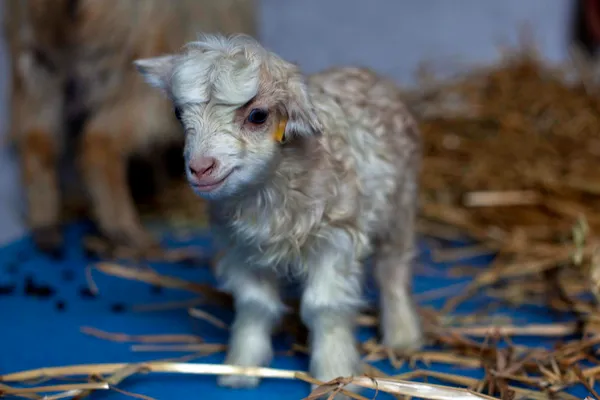
In the realm of Kashmiri Pashmina, the source of its luxurious wool is the revered Pashmina goat. In a fascinating turn of events, science and technology intersected with tradition when the world witnessed the birth of the first cloned Pashmina goat named Noori on March 9, 2012. Noori's arrival marked a significant breakthrough in the cloning of endangered species, and her unique birth process added a new chapter to the story of preserving the precious Pashmina lineage.
Noori's creation involved a remarkable collaborative effort from three different goats, each playing a distinct role in the cloning process. The first goat provided the egg, the second contributed the DNA, and the third carried the cloned embryo to term. This intricate process showcased the delicate dance between modern biotechnology and the age-old artistry associated with Pashmina production.
The successful cloning of a Pashmina goat like Noori had implications beyond scientific achievement. It signaled the potential for conservation efforts, particularly in the context of preserving endangered species. Pashmina goats are not only vital for the production of luxurious wool but are also an integral part of the fragile Himalayan ecosystem. By exploring cloning techniques, scientists sought to address concerns related to the declining population of these goats while ensuring the sustainable production of Pashmina.
Advancements in Breeding Techniques
Advancements in breeding techniques have been a subject of ongoing research to enhance the quality of Cashmere wool. The cloning of Pashmina goats represents a pioneering step toward maintaining genetic diversity and improving the traits associated with Cashmere production. Selective breeding and genetic advancements aim to develop healthier, more resilient goats that yield finer and more abundant wool.
Cloning remains a controversial and complex area of scientific exploration. Yet, its application in the context of Pashmina goats sheds light on the intricate balance between tradition and innovation. The birth of Noori exemplifies the potential for technology to contribute to the conservation and sustainability of Pashmina production. It also showcases the effect of technological advancements to sustain ecosystems in which these goats thrive. The cloning of Pashmina goats stands as a testament to the intersection of science and tradition. Hence, it charts new possibilities for the future of this coveted and culturally significant fabric.
Pashmina vs. Shahtoosh
Pashmina and Shahtoosh are two exquisite fabrics renowned for their luxurious textiles. However, they differ significantly in their origins, production processes, and ethical considerations. Understanding the distinctions between these materials is crucial for appreciating their unique qualities and addressing conservation concerns.
Pashmina:

Origins and Production:
- Cashmere, which is used to make Pashmina shawls is derived from Pashmina goat. It is native to the Himalayan region, including parts of India, Nepal, and Tibet.
- The process involves combing the fine undercoat of the goat, known as Cashmere, which is then hand-spun and woven into fabric.
- Pashmina is celebrated for its softness, warmth, and lightweight feel, making it a prized material for luxurious shawls and scarves.
Ethical Considerations:
- Pashmina is generally produced through ethical and sustainable practices, with a focus on preserving the well-being of the Pashmina goat.
- The traditional methods of Pashmina production involve handcrafting, contributing to the livelihoods of local artisans and communities.
Shahtoosh:
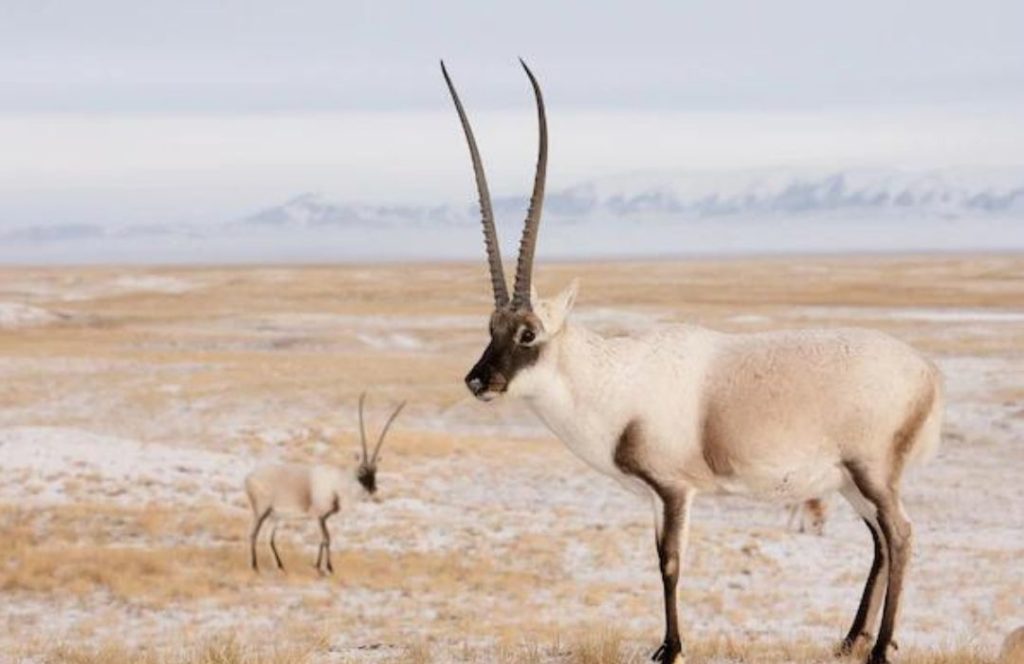
Origins and Production:
- Shahtoosh comes from the wool of the Tibetan antelope, also known as the chiru or shahtoosh antelope.
- The wool is obtained from the neck and underbelly of the chiru, which is an endangered species. This extraction process involves killing the animal, making the production highly controversial.
- The incredibly fine wool is then woven into shawls, known for their unmatched softness and warmth.
Ethical Considerations:
- Shahtoosh production raises serious ethical concerns due to its association with the killing of endangered chiru antelopes.
- The Convention on International Trade in Endangered Species of Wild Fauna and Flora (CITES) has banned the trade of Shahtoosh globally, recognizing the need to protect these endangered animals.
Legal Implications and Conservation:
- Pashmina faces fewer legal and conservation concerns compared to Shahtoosh. The Pashmina goat, while important for its wool, is not an endangered species.
- Shahtoosh, on the other hand, is subject to strict international regulations due to the critical status of the chiru antelope. The ban on the Shahtoosh trade aims to prevent further harm to this endangered species.
In conclusion, while both Pashmina and Shahtoosh offer unparalleled luxury, the stark differences in their origins and production methods have led to distinct legal implications and ethical considerations. Pashmina, with its sustainable practices and focus on animal welfare, represents a more responsible choice, especially in light of the conservation challenges associated with Shahtoosh. Understanding and appreciating these differences contribute to informed consumer choices and the promotion of ethical and sustainable practices in the realm of luxurious fabrics.
Hand Weaving Tradition
The hand-weaving tradition of Pashmina is an intricate and time-honored process. It plays a pivotal role in transforming raw Cashmere wool into the luxurious fabric that has captivated the world for centuries. This traditional craftsmanship not only ensures the exquisite quality of Pashmina but also reflects the cultural heritage and artisanal skills passed down through generations.
The Cashmere Wool
The journey begins with the collection of Cashmere from the underbelly of the Ladakhi goat during the spring molting season. Artisans carefully comb and collect the fine undercoat, which is famous for its softness and warmth. They then sort and clean it, and prepare it for the meticulous hand-weaving process.
Hand-Spinning
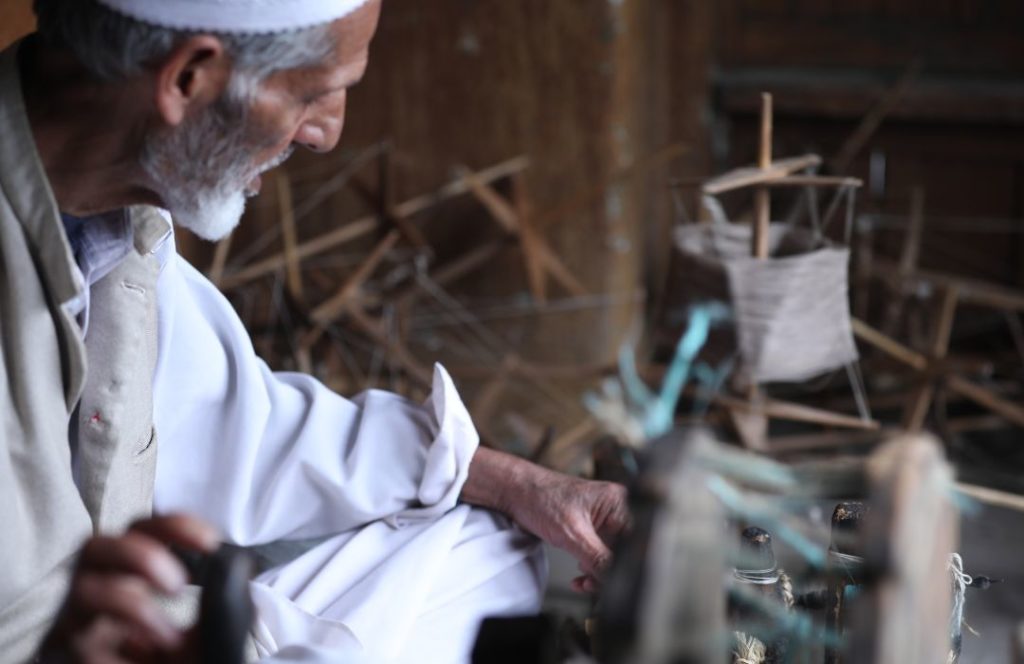
The cleaned fibers are then hand-spun by skilled artisans. This process involves spinning the delicate fibers into yarn using a spinning wheel or spindle. Hand-spinning allows for greater control over the thickness and consistency of the yarn, resulting in a more uniform and refined texture.
If the design calls for colored Pashmina, the hand-spun yarn may undergo a dyeing process using natural or synthetic dyes. Artisans carefully immerse the yarn into the dye, ensuring even saturation and vibrant coloration.
Traditional Loom Weaving
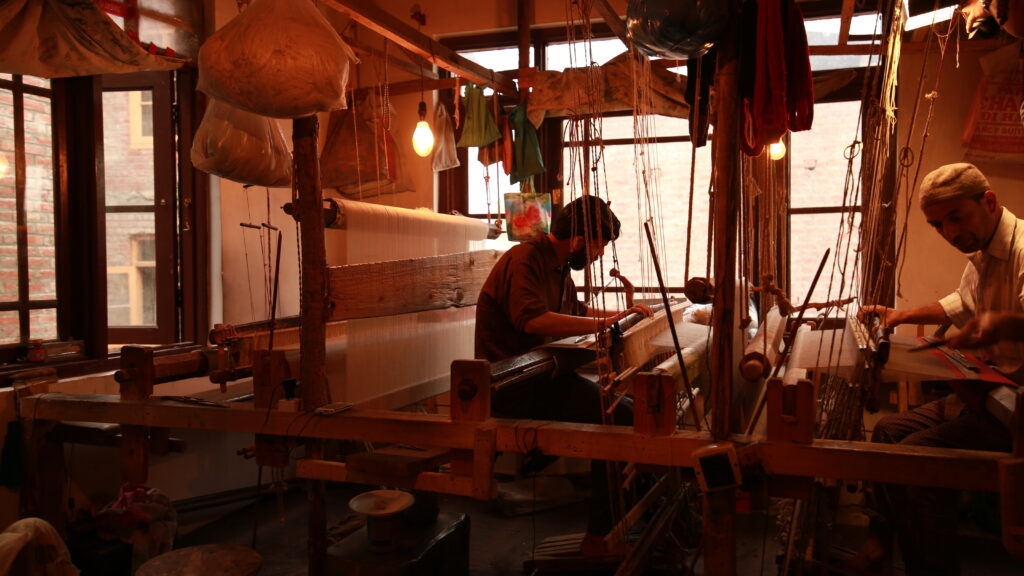
The heart of Pashmina production lies in the traditional handloom. Skilled weavers, often with years of experience, set up the loom and meticulously interlace the dyed or natural-colored yarns. This process requires precision and patience as each thread contributes to the overall pattern and texture of the fabric.
Intricate Designs and Patterns
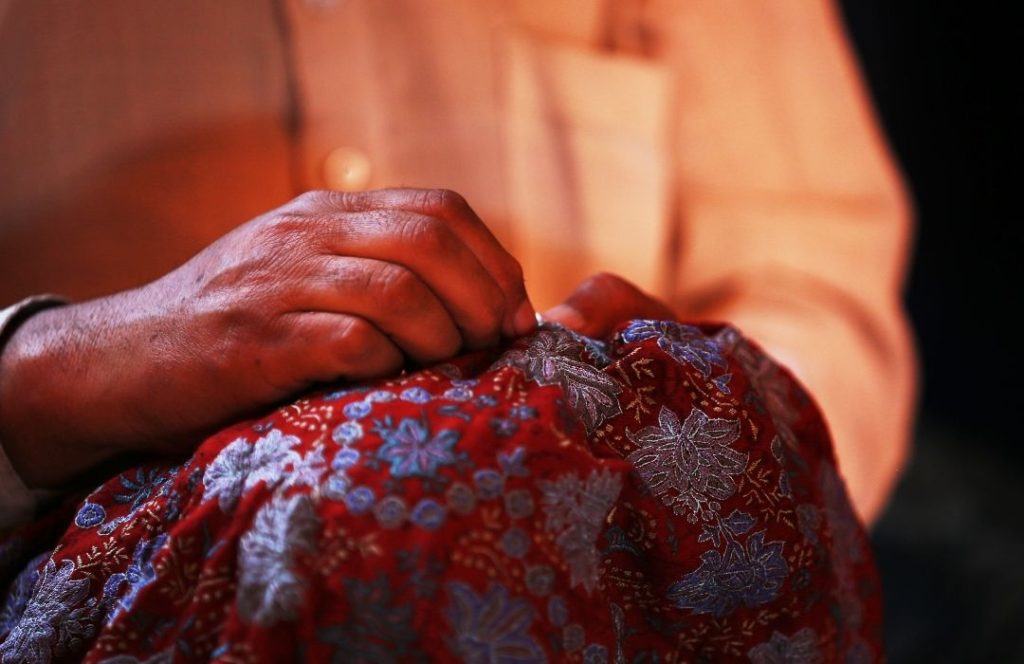
The true beauty of Pashmina lies in its intricate designs and patterns. Artisans may weave traditional motifs such as paisleys, florals, or geometric shapes. The complex craftsmanship involved in creating these designs requires a deep understanding of the weaving techniques and a keen eye for detail.
After the weaving is complete, the Pashmina undergoes several finishing processes. This may include washing, blocking, and pressing to achieve the desired texture and dimensions. Artisans take great care to ensure the final product meets the highest standards of quality.
Empowering Artisan Communities
The hand-making of Pashmina does produce a luxurious fabric. But it also serves as a significant source of livelihood for artisan communities in the Kashmir region. This ancient craft empowers skilled weavers, often women, providing them with a sustainable income. Hence, it preserves a cultural heritage that has thrived for centuries.
Therefore, the hand-making tradition of Pashmina is a labor-intensive and skill-dependent process. This process elevates the fabric to unparalleled levels of quality and artistry. This meticulous craftsmanship not only produces a product of exquisite beauty but also contributes to the preservation of cultural traditions and the well-being of artisan communities in the Himalayan region.
Unmatched Softness
One of the most enchanting and distinctive features of Cashmere wool is its unparalleled softness, a quality that has contributed to its legendary status in the world of luxury Pashmina shawls. The softness of Pashmina is so extraordinary that it stands out even among the finest natural fibers, making it a coveted material for those seeking an indulgent and sumptuous experience.
The Origin of Softness

The journey to the exceptional softness of Cashmere begins with the unique underbelly fleece of the Pashmina goat. During the molting season, this fine undercoat is carefully combed and collected, revealing fibers that are incredibly soft, lightweight, and delicate. Unlike coarser outer hairs, the undercoat possesses a rare quality that sets Pashmina apart.
Exceptional Fineness

The key to the unmatched softness lies in the fineness of Pashmina fibers. The diameter of these fibers is incredibly small, measuring less than 15 microns in many cases. This fine micron count is a testament to the exquisite quality of Pashmina wool, placing it among the finest natural fibers available.
Passing through a Ring
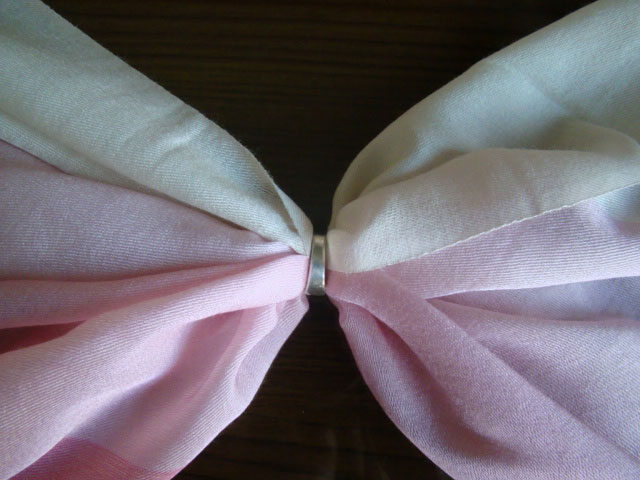
A captivating testament to the fineness of Pashmina is its ability to pass through the opening of a ring. This remarkable characteristic showcases the incredibly thin and supple nature of the fibers. When gently threaded through the aperture of a ring, the Pashmina wool effortlessly glides, underscoring its luxurious softness.
Luxurious Comfort for the Skin
The exceptional softness of Pashmina extends beyond its visual appeal to provide a luxurious tactile experience. When draped over the shoulders or worn as a shawl, the fabric envelops the wearer in a cocoon of comfort. The delicate touch of Pashmina against the skin is not just a physical sensation but a sensory indulgence, creating a feeling of opulence and well-being.
Preserving Softness through Craftsmanship
Traditional handcrafting plays a crucial role in preserving the inherent softness of Pashmina. Skilled artisans, with their expertise and meticulous craftsmanship, ensure that the delicate fibers are handled with care. The hand-spun and hand-woven techniques contribute to maintaining the integrity of the wool, allowing its natural softness to shine through in the final product.
The unmatched softness of Pashmina is a testament to the inherent quality of its fibers. From the careful collection of the undercoat to the skilled hands of artisans during the making process, every step contributes to preserving and showcasing the extraordinary softness that defines Pashmina as a symbol of luxurious comfort and indulgence.
Also read: 10 MUST-HAVE PASHMINA SHAWLS FOR THIS WINTER
Intricate Hand Embroideries of Kashmiri Pashmina
The allure of a Pashmina shawl extends beyond its softness and warmth, transcending into a realm of exquisite artistry through intricate hand embroideries. Among the various embroidery techniques that grace Pashmina shawls, Sozni and Tilla's work stands out as epitomes of craftsmanship, each telling a story of tradition, skill, and dedication.
Sozni Embroidery:
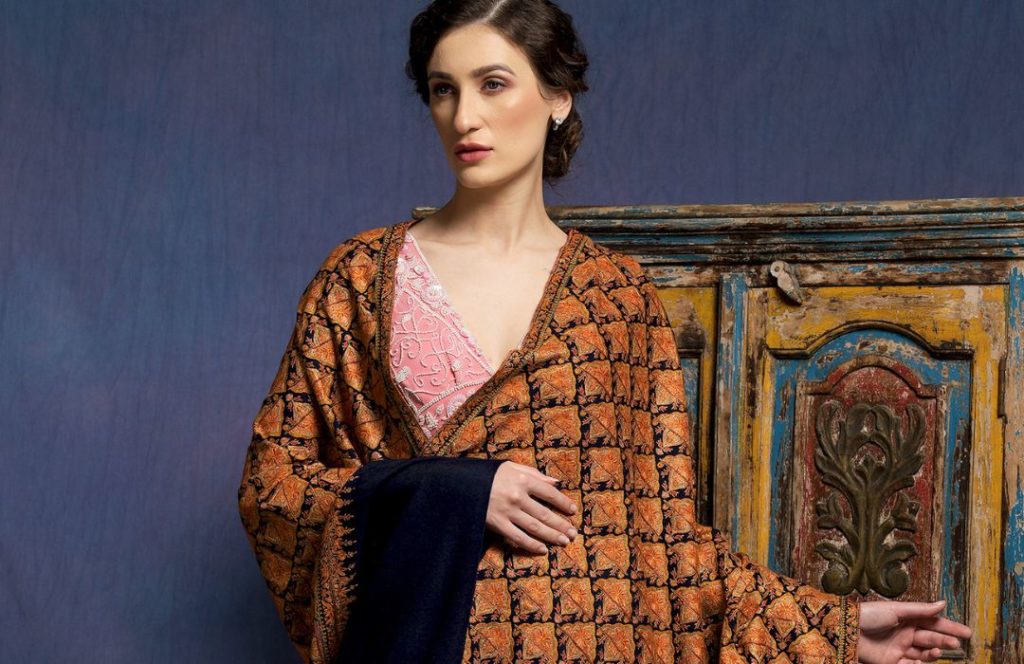
Rooted in Tradition: Sozni embroidery is an age-old tradition that finds its origins in Kashmir, where artisans meticulously create delicate patterns using fine needles and colorful threads. Traditionally, this intricate embroidery was done by hand, with each artisan contributing to the creation of a masterpiece.
Intricate Patterns: Sozni's work is characterized by its fine and detailed patterns, often featuring motifs inspired by nature, Persian art, and Kashmiri culture. Floral designs, paisleys, and geometric shapes come to life on the canvas of Pashmina, enhancing the beauty of the fabric. The finesse of Sozni embroidery lies in the ability of artisans to create complex and visually appealing patterns that complement the elegance of Pashmina.
Specialist Artisans: The embroidery is a specialized skill that requires years of training and a keen eye for detail. Specialist artisans, often following family traditions, devote themselves to perfecting this art form. Their expertise allows them to work with precision, creating symmetrical and harmonious designs that elevate the aesthetic appeal of Pashmina shawls.
Tilla Work:

Embellishing with Gold and Silver: Tilla's work involves the use of metallic threads, dipped in real gold or silver, to embellish the surface of Pashmina shawls. The metallic threads are carefully woven into the fabric, creating a shimmering effect that adds a touch of opulence to the shawl. Tilla's work often includes intricate patterns and motifs, enhancing the overall beauty of the Pashmina.
Luxurious Detailing: The use of metallic threads in Tilla's work imparts a luxurious touch to Pashmina shawls. Artisans skillfully incorporate the metallic elements into the fabric, ensuring a balance between richness and subtlety. This form of embroidery is a celebration of luxury and refinement, making Pashmina shawls adorned with Tilla work highly coveted.
Mastering the Craft: Similar to Sozni embroidery, Tilla's work requires a high level of skill and precision. Artisans specializing in Tilla work undergo rigorous training to master the art of embellishing Pashmina with metallic threads. The result is a breathtaking fusion of tradition and glamour, transforming the Pashmina shawl into a wearable work of art.
The intricate hand embroideries of Sozni and Tilla's work elevate the Pashmina shawl from a mere accessory to a masterpiece of art and craftsmanship. These traditional techniques passed down through generations, showcase the dedication of skilled artisans who breathe life into each shawl, making it a testament to the rich cultural heritage of Kashmir.
Also read: CHALLENGES FACED BY PASHMINA ENTHUSIASTS
Long Production Time
The creation of a Pashmina shawl is not a swift process; instead, it is a labor-intensive journey that demands time, skill, and unwavering dedication. The extended production time of Pashmina shawls, at times stretching to several years is indeed a testament to the meticulous craftsmanship involved and the commitment of artisans to preserve the essence of this luxurious fabric.
Selecting the Finest Wool:
The journey of a Pashmina shawl begins with the selection of the finest wool. Harvested from the soft underbelly of the Pashmina goat during the spring molting season, the wool is renowned for its exceptional quality and fineness. Artisans meticulously inspect and handpick the fibers, ensuring that only the finest strands are chosen for the crafting process.
Hand Spinning and Weaving:
One of the distinctive aspects of Pashmina production is the traditional method of hand spinning. Skilled artisans spin the delicate fibers into yarn using a spinning wheel, a process that requires precision and a deep understanding of the delicate nature of the material. This hand-spun yarn forms the foundation of the shawl, contributing to its unique texture and quality.
The hand-spun yarn is then woven into the fabric through a traditional hand-weaving process. Artisans use handlooms to create the intricate patterns that characterize Pashmina shawls. This method allows for meticulous attention to detail, ensuring that each thread is carefully placed to achieve the desired design. Hand weaving adds a personalized touch to each shawl, making it a one-of-a-kind piece of wearable art.
If the Pashmina shawl involves intricate hand embroidery, this stage further extends the production time. Specialist artisans painstakingly embellish the shawl with intricate patterns, using techniques such as Sozni and Tilla's work. The time and effort invested in hand embroidery contribute to the uniqueness and exclusivity of each piece.
Patience and Tradition:
The prolonged production time of Pashmina shawls is not merely a result of the intricate processes involved; it is a reflection of the patience and commitment embedded in Kashmir's rich weaving tradition. Artisans, often working within the confines of their homes or small workshops, pour their time and expertise into each shawl, ensuring that the final product meets the highest standards of quality and craftsmanship.
In conclusion, the extended production time of Pashmina shawls is a deliberate choice, preserving traditional methods and allowing artisans to create pieces that embody the essence of luxury and heritage. Each shawl, with its extended timeline of creation, becomes a masterpiece. Further, it stands as a testament to the enduring craftsmanship of Kashmiri artisans
Sustainability
In recent years, sustainability has become a pivotal consideration in various industries, including the realm of luxury textiles. The Pashmina industry in Kashmir has not been oblivious to this global shift in consciousness. While Pashmina itself is a natural and biodegradable material, the sustainability of the industry involves considerations beyond the raw material, encompassing ethical practices, environmental impact, and the well-being of the artisan communities.
Ethical Sourcing and Fair Trade Practices:
Sustainability in the Pashmina industry starts with ethical sourcing of the raw materials. Efforts are made to ensure that Pashmina goat farming practices adhere to ethical standards, promoting the well-being of the animals. Fair trade practices are also increasingly emphasized to ensure that the communities involved in Pashmina production are treated justly. Fair wages, safe working conditions, and community development initiatives contribute to a more sustainable and socially responsible industry.
Conservation of Pashmina Goats:
Pashmina goats are integral to the industry. Hence their well-being is crucial for the sustainability of Pashmina production. Initiatives are being taken to conserve and protect Pashmina goats, including responsible breeding practices and measures to prevent overgrazing in the Himalayan regions. These efforts aim to maintain a balance between sustaining the livelihoods of herders and conserving the fragile ecosystem in which the goats thrive.
Environmental Impact of Dyeing Practices:
While the traditional use of natural dyes in Pashmina production is inherently eco-friendly, there is a growing awareness of the environmental impact of dyeing practices. Sustainable dyeing techniques, such as low-impact or plant-based dyes, are being explored to minimize the ecological footprint of Pashmina manufacturing. This shift aligns with the global movement towards environmentally conscious practices in the fashion and textile industry.
Empowering Women and Artisan Communities:
Another facet of sustainability in the Pashmina industry is the empowerment of women and local artisan communities. By providing fair wages, training programs, and opportunities for skill development, the industry contributes to the economic and social well-being of these communities. Empowered artisans are more likely to uphold traditional craftsmanship, ensuring the continuity of Pashmina's rich heritage.
Conservation of Authenticity:
The Geographical Indication (GI) tag not only safeguards the authenticity of Kashmiri Pashmina but also contributes to the conservation of traditional weaving techniques. This legal protection ensures that Pashmina is produced within the geographical boundaries of Kashmir, preserving the uniqueness of the craft and preventing exploitation or imitation.
Educational Initiatives:
Sustainability in the Pashmina industry extends to educational initiatives aimed at creating awareness about the cultural and ecological importance of Pashmina. By educating consumers and stakeholders, the industry promotes responsible consumption and appreciation for the artisanal value of Pashmina.
Conclusion
In unraveling the lesser-known facts about Kashmiri Pashmina, we've ventured into a world where tradition meets innovation. The story of each shawl is woven with threads of history, culture, and unparalleled craftsmanship. The Geographical Indication tag stands as a guardian, ensuring the authenticity of Kashmiri Pashmina, while the cloning of Pashmina goats and the competition with Shahtoosh underscore the delicate balance between tradition and conservation.
The meticulous hand-weaving process, the almost ethereal softness that allows Pashmina to pass through a ring, and the intricate hand embroideries showcase the artistry embedded in each piece. The long production time becomes a testament to the dedication of artisans. It turns Pashmina into not just a luxury item but a labor of love.
As we delve into the sustainability aspects, the industry's commitment to ethical sourcing, fair trade, and environmental consciousness adds another layer to the Pashmina narrative. Empowering women, conserving Pashmina goats, and embracing educational initiatives further enrich the story.
In conclusion, every thread contributes to a heritage that transcends time. It's a symphony of art, culture, and sustainability, inviting us to cherish not just the warmth of the shawl but the depth of its legacy. As we wrap ourselves in the embrace of Pashmina, may we also wrap our hearts around the stories and traditions woven into its very fabric.